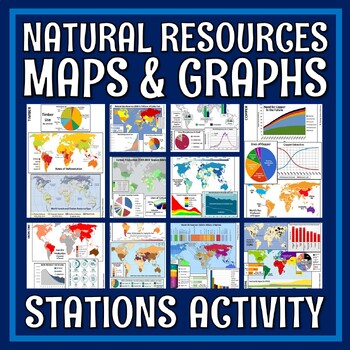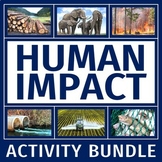Uneven Distribution of Natural Resources Activity Analyze Maps Graphs MS-ESS3-1
- PDF
- Google Apps™
- Easel Activity

What educators are saying
Also included in
- Never search for "something to do tomorrow" ever again! This bundle contains PRINT AND GO lessons, NO PREP activities, LOW PREP labs, and ENGAGING articles to supplement and thoroughly enhance an Earth and space science course. Every included resource is easy to implement, standards-based, and high-Price $399.99Original Price $639.06Save $239.07
- SAVE MORE THAN 30% on a complete activity-based Uneven Distribution of Natural Resources lesson unit! This bundle includes every resource you need to teach and assess NGSS MS-ESS3-1. All of the work has been done for you - from start to finish!These 7 resources form a COMPLETE AND COMPREHENSIVE UNITPrice $19.99Original Price $29.44Save $9.45
- SAVE 35% off list prices! Engage students with CRITICAL THINKING as you teach them about how humans have impacted ecosystems around the world. The 12 included resources provide fun, NGSS-based activities for each of the following topics:Habitat Destruction Overharvested ResourcesInvasive SpeciesWatPrice $39.99Original Price $62.90Save $22.91
Description
Great way to practice data analysis as students learn about natural resources! Students analyze MAPS and GRAPHS of natural resource distribution and use. Includes both PRINT and GOOGLE SLIDES versions of the activity.
⭐ Find this activity in our DISTRIBUTION OF NATURAL RESOURCES UNIT!
This document includes:
- 10 Natural Resource Data Stations: Each station has maps and graphs to analyze for information such as resource distribution, use, risk of depletion, and impact on the environment. Each station focuses on just one natural resource at a time.
- Student Sheet: This worksheet asks questions that guide students through examining the data at each station.
EASY PREP and easy to assign!
Only 1 color copy per station is required (10 color pages total). Students can circulate throughout the stations, so there is no need to make color copies for each student. Each student or group needs one black-and-white answer sheet each.
10 Natural Resources Included: iron ore, natural gas, oil, coal, cotton, timber, fish, phosphorous, water, copper
Teacher Notes:
- Answer key is included.
- Please note that this resource is not editable.
- GO PAPERLESS! Use the included digital Google Slides version.
- NGSS Standard: MS-ESS3-1
- NGSS Science & Engineering Practice: Analyzing and interpreting data
- Save $$$ with our DISTRIBUTION OF NATURAL RESOURCES UNIT!
⭐⭐⭐ Click here to get 5 FREE EARTH & SPACE SCIENCE lessons! ⭐⭐⭐









